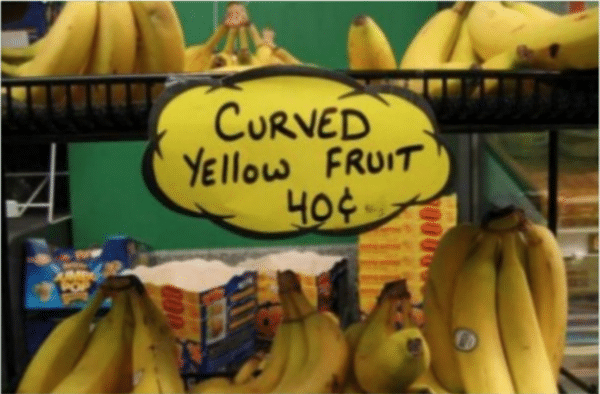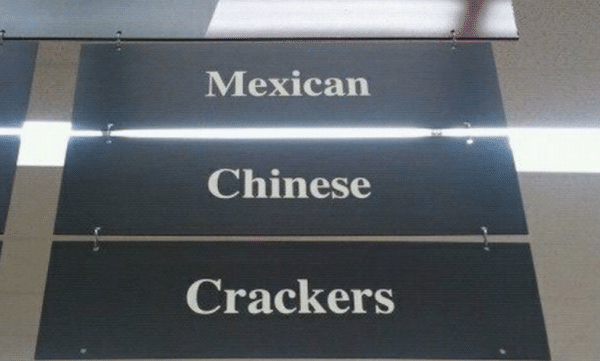
Everyone agreed that the tofu was problematic.
On a Monday night in May, Content Strategy Inc senior content strategist Blaine Kyllo handed out dozens of 2 x 3” cards—one set for each of the three groups of assembled at the Vancouver Information Architecture and Content Strategy Meetup.
Each card had a food product written on it, and the groups were asked to organize the cards into categories. Some categories—fruit, breads, fish— came together quite quickly. But the bean curd simply refused to be easily classified.
Blaine kicked off the meetup with the food classification card sort as a quick way to get the crowd thinking about taxonomies.
At the end of the exercise, he asked the audience where they might expect to find all the terms listed on the cards. Answers were varied. One participant surmised that the card labels could be ingredients in a cookbook. Others pointed to the “correct” conclusion, a grocery store.
Welcome to taxonomies
“With taxonomies, there is no right or wrong. And you have to make compromises. Some things don’t really have a place at all,” said Blaine. “You’re constantly stumbling up against these problems.”
“Where tofu goes in a grocery store depends on a number of factors. One reason it ends up in the dairy section is because that’s where the refrigerators are and some tofu needs to be refrigerated, so it’s convenience as much as anything else.”
Blaine was first introduced to the taxonomy game, created by John Horodyski of Optimity Advisors at a workshop dominated by librarians.
Blaine noted that Horodyski’s taxonomy exercise demonstrates three things:
- Taxonomies are all around us, and we see them all the time without recognizing them.
- Taxonomies can be very simple.
- Taxonomies are never right. They are only versions of the truth.
Blaine guessed that many of us had our first introduction to formal taxonomies when we learned about the family, genus, and species groupings of the animal kingdom.
What’s the connection with taxonomy in content strategy?
Blaine asked the audience to imagine a content experience that is simply thrown together, one with no taxonomy at all, versus a taxonomically organized content experience based on user needs.
“If we’re basing this experience on the user, then the question we should ask is, who is that user,” Blaine said. “Who makes up the audience? Is it new parents? Is it female CEOs? Maybe it’s kids or robots, or people learning how to cook. Could be nudists. Or cyclists. Or nude cyclists?”
Determining the audience happens with user research, Blaine insisted. Knowing your audience through focus groups, surveys, and one-on-one interviews is a key starting point for many things that optimize your content experience, including taxonomy.
“Once you’ve identified the audience, the next step is to get insights into their needs,” Blaine said. “You can look at search and call logs, talk to your customer service reps, and find out what terms people are using when they call in. You can audit your own content, find out what words other departments and functional teams are using to describe products and services, and build your own list of terms that you can start sorting.”
Then, Blaine suggested, look for themes and relationships as you organize those terms. If you have terms that don’t fit in, leave them on their own until you have enough similar terms.

Remember to keep things simple and relatable, while this indeed a curved yellow fruit, ‘banana’ is a much simpler way to refer to it.
In the same way that comprises had to be made when figuring out where to put the tofu, choices will also need to be made when building a taxonomy.
“It’s best to use terms that makes the most sense to your audience,” said Blaine. “If your audience is toddlers, it might be ‘kitty.’ If your audience is zoologists, it could be ‘Felis catus.’ Taxonomies are built with synonyms in mind, so while multiple terms can be used, they should all point to the preferred term.”
Caveat: Tags and metadata are not taxonomies
“I know what you’re thinking, taxonomies are all about terms,” said Blaine. “And we have tags on all our blog posts, so we must have a taxonomy. Not so fast.”
- Tags themselves are not taxonomies. You can use your taxonomic terms as tags, but the tags themselves are not taxonomy. Taxonomy is not just a list of words—it’s a controlled vocabulary.
- Metadata is information about information. Metadata describes the content and taxonomy organizes the content. Taxonomical terms should be stored as metadata, but metadata itself isn’t taxonomy.
Thus, the need for a taxonomy running in the background, insisted Blaine.
Taxonomies are a building block for consistent, structured content
“Everyone using the same words for things enables content re-use because you can connect your content through your terms,” said Blaine. “The synonyms that are part of taxonomy also make it easier to surface related content that make sense or to personalize content based on user need.”
The taxonomy in place on the website of an outdoor recreation store, for example, makes it easier for people to look up different types of jackets. Blaine used the example of his wife looking for a rain jacket with a particular feature: “The taxonomy allows her to filter out jackets with breathable fabrics from all others. This is all enabled by taxonomy.”
“Implementing a taxonomy will improve the search function of your site, making it easier for users to search for the content they are looking for,” said Blaine. “And it also leads to a better information architecture, making it easier for users to navigate to the content.”
Heeding context: language, dual meanings, and outdated content
Compiling a taxonomy creates a more mindful experience around outdated content, dual meanings and language duplications (the word ‘pain’ has entirely different meanings in French and English, Blaine pointed out) is key to a clear and successful user experience.
Get started tomorrow
To summarize his talk, Blaine encouraged everyone to start small. “It’s an ongoing, evolving exercise.”
You can get started by collecting terms in a spreadsheet. Talk to other departments about the words they use and make sure to relate synonyms and differentiate between internal terms and those preferred by your key audiences.
Don’t wait until it’s done, and don’t wait until it’s perfect, because taxonomies will never be either of those things. They are living things that will change – and get better – over time.
Further reading
Apples and oranges; lions and tigers [Presentation slides]




